7 Things Everyone Using Anki Should Know14 min read
Check out my 2 hour + class on Anki for FREE on Skillshare
Anki is the best way to memorize anything. But are you using it right?
The forget function, learning intervals, card customization, missed questions, add-ons–do you use these things with your Anki cards? You probably should. In this post, I’ll review 11 less well-known tips for maximizing your retention when using Anki.
Anki revolutionized how I study; if you don’t know what Anki is, I recommend you watch one of my earlier videos or join my class for a complete guide, as this video has specific, more advanced tips.
Let’s get started.
1. UNDERSTAND>MEMORIZE
This is the most important tip of the entire video. You must understand before you memorize. Anki is amazing for memorization; however, not so good for understanding. Whenever you go over a card using Anki, it should be for revision and reminding yourself of a topic you already understand.
So, what I would do, is before you go into using the flashcards on Anki, I would make sure you have a basic understanding based on the third-party video you watched, a class lecture, or the textbook, and then start to review your flaschards.
If you want to make sure you understand the general topic, I would use the Feynman Technique and try and explain the topic broadly and simply as if you were explaining the topic to a 12-year-old. However, don’t use this for every flashcard because that would be overkill. But, if you have 100 flashcards on understanding the murmurs of the heart, I would see if you can generally explain why the heart might have a murmur, explaining the various valves and what might happen to them.
Some settings I would make sure to have on your Anki would be:
- V3 scheduler enabled (fixes undo, fuzz factor, interlay learning, better setting adjustability)
- Insertion of new cards: sequential (V3 will take care of randomization for us)
- Display order of cards: new cards after reviews (I like to make sure I’ve reviewed the old before starting the new because staying consistent with reviews is the most important thing)
- Interlay learning/review order: mix with reviews
- Review sort order: due date, then random
- Bury new siblings enabled
- Bury review siblings enabled
- bury interlay learning siblings enabled

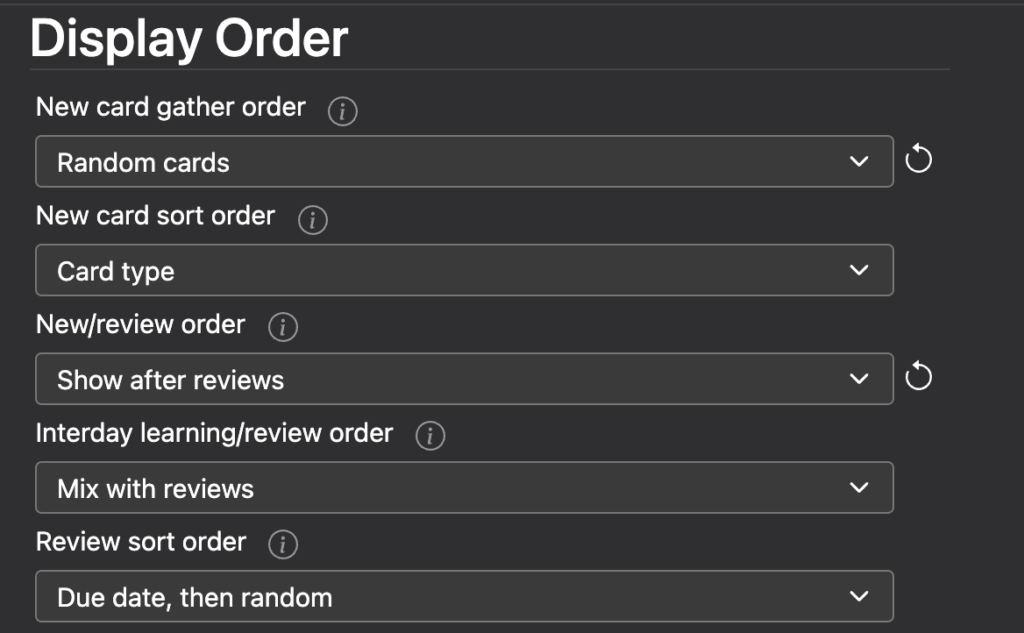
2. Missed Questions + Forget Function
Wrong questions should be linked to Anki cards. It seems obvious, but we usually look at the wrong question and then go on to the next one. We should really identify the piece of information we didn’t understand in that question and then either create a new flashcard out of it or find an old flashcard that we forgot.
For example, in medical school, there are tons of practice questions and premade flaschards; whenever I get a question wrong, I search my Anki deck for the content of that question, trying to figure out which part of that question I got wrong. Then, what I will do, is two things:
- Use the forget function: if I got that question wrong, I have not retained that information, so, what I do, is “forget” that flashcard—resetting it like a new card.
- Just go to browse → highlight the card → right click it → click “forget” → the card is now a new card.
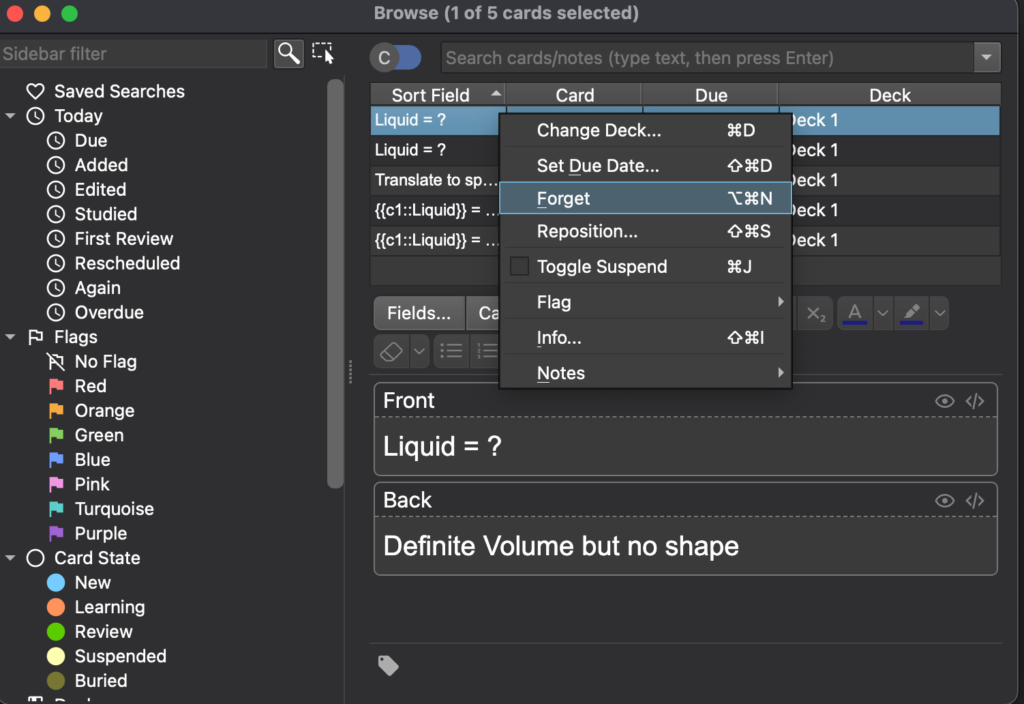
- Add a “missed question section”: This is where I take a screenshot or picture of the question I got wrong and paste that into the flashcard. There are lovely explanations ontice sets most of my prac; I don’t want to lose those!
- This is a little more complicated; you need to know what note type you are using; you can do this by going to browse → right-clicking the card →, and checking the “info” section; for example, the card pictured is a “basic (and reversed card)” note type.
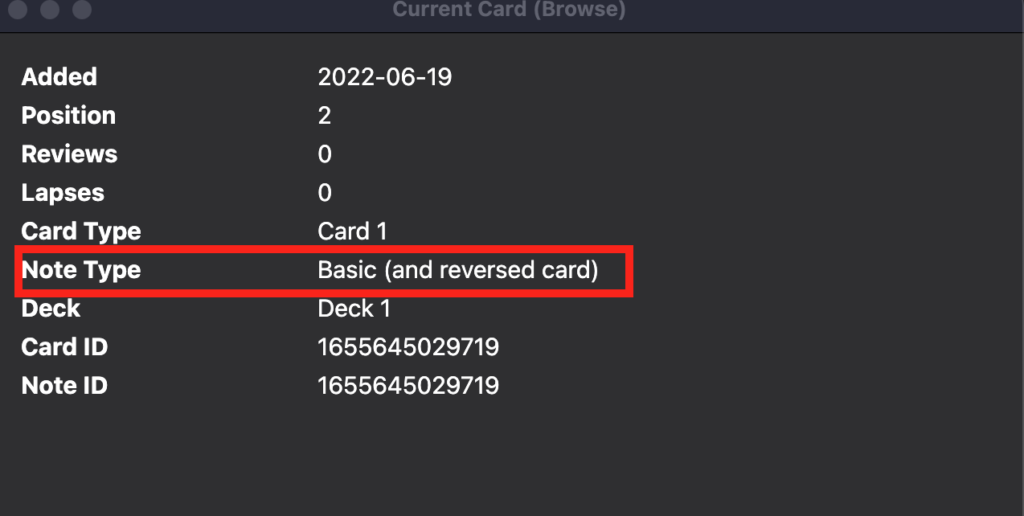
- The next thing to do is add a new “field,” which is just adding an extra section to every card with that “note type” so you can input whatever text you want. I would add a “missed questions” field.
- To do this, go to tools → manage note type → select the note type we identified earlier → select “fields” → hit “add” → type in “missed question” → click “save” → go into browse and find that exact card → screenshot the incorrect question and paste it into the “missed question section” → success!
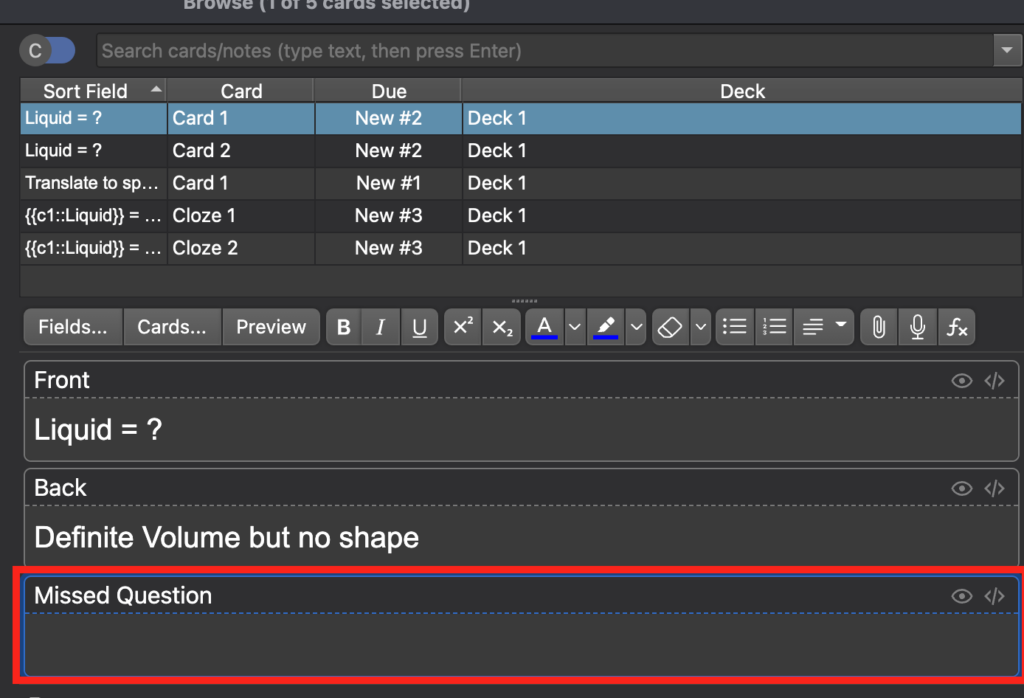
Now, in my Anki deck, I have tons of extra fields as my deck is a premed deck from the AnKing (who does amazing stuff). Some fields you might want to add:
- Missed Questions
- Lecture Notes
- Textbook
- Helpful Videos
- Extra Question (Connect)
Focusing on the specific information in questions you got wrong is one of the best ways to maximize your efficiency when studying with Anki.
3. Customizing Cards
Adding extra fields, as described earlier, is one of the best ways to customize cards so that you can retain information.
Now, this is a bit extra work, but I find customizing cards in relation to bolding and underlining helps cue your brain to vital information. Anything that makes studying a little nicer is great. For example, the best Anki cards are straightforward with the essential information that you should remember bolded, and the most important news, the information you will be tested on, is underlined.

The general theme of this tip is not just underlining and bolding your questions but adding extra information. The more you know about specific details, the more you will understand. As a bonus, if you can even connect to other topics while studying, this will help you remember even more. For example, I might add a section on specific flashcards called “extra questions.” In that field, I may ask myself a second question based on the content I just studied.
So, for example, in the card I just showed you, I might add a question about what happens when your platelet counts are low. I will include the answer under that.

4. Figuring out the Perfect Interval for your Goal Retention
An extra multiplier is applied to all reviews. At its default of 1.00, it does nothing. If you set it to 0.80, though, for example, intervals will be generated at 80% of their normal size (so a 10s day interval would become 8 days). You can thus use the multiplier to make Anki present cards more or less frequently than it would otherwise, trading study time for retention or vice versa.
For moderately complex material, the average user should find they remember approximately 90% of mature cards that come up for review. You can find out your performance by opening the graphs/statistics for a deck and looking at the Answer Buttons graph – mature retention is the correct% on the right side of the graph. If you haven’t been studying long, you may not have any mature cards yet. As performance with new cards and younger cards can vary considerably, it’s a good idea to wait until you have a reasonable amount of mature reviews before you start concluding your retention rate.
On the SuperMemo website, they suggest that you can find an appropriate multiplier for a desired retention rate. Their formula boils down to:
log(desired retention%) / log(current retention%)
Imagine we have a current retention rate of 85% and we want to increase it to 90%. We’d calculate the modifier as:
log(90%) / log(85%) = 0.65
You can use Google to calculate it for you.
If you plug the resulting 65% into the interval modifier, you should find that your retention moves closer to your desired time retention over .
One important thing to note, however, is that the trade-off between time spent studying and retention is not linear: we can see here that to increase our retention by 5 percentage points, we would have to study 35% more frequently. If the material you are learning is very important, then it may be worth the extra effort – that is, of course, something you will need to decide for yourself. If you are simply worried that you forget too much, then you may find investing more time at the initial learning stage and using mnemonics will give you more gain for less effort.
One final thing to note is that Anki forces a new interval to be at least 1 day longer than it was previously so that you do not get stuck reviewing with the same interval forever. If your goal is to repeat a card once a day for multiple days, you can do that by setting more learning mode steps instead of adjusting this modifier.
I like to aim for a Success Rate of the very high 80s. My reasoning is that I want to score well on Step, we can score well by having a high success rate, however, as we try and push that success rate up the work exponentially increases (something like 30% extra work for 5% gains). Now, that’s ok for me, to a point. I tried pushing over the 90% hump and my card count got too high. Also, many other people seem to emphasize an 80-90% success rate. So, like finding just the right temperature of oatmeal, I decided on trying to hit as close to 90% without passing it. I’m doing pretty well with that.

To get this information just download the true retention app → restart Anki → “Shift-Click” Stats on your deck browser.
What I would do, over the past two years, is monthly. I would check up on this number. If I felt I was seeing too many cards and maybe pushing past 90%, I would increase my interval modifier by 5% to see the cards farther apart.
If I felt I saw too few cards and my retention rate dropped to the mid-80s, I would decrease my interval modifier by 5% to see the cards more frequently.
So what do I suggest for you? I am pretty happy with my current setup; I don’t think it’s a bad place to aim for. Play with that interval modifier slowly and carefully, and don’t rely on statistics from one day or even one week.
Next things to talk about the maximum interval.

I will defer to a great post by Reddit user u/nicolascuri, but he says we should never cap our max interval. I agree with him. Unnecessary repetitions are precisely that, unnecessary.
5. Learn or Kill the cards that are taking up the most time
Before you can take advantage of this tip you need to download Advanced Browser which you can here: link (code: 874215009).
This fantastic app lets you see how much time you spend on each card you are working on. This is important because we can see which cards are taking up most of our time; which cards are sucking our efficiency away. Importantly, there is an option to examine the average review time. However, I find total time is more critical.
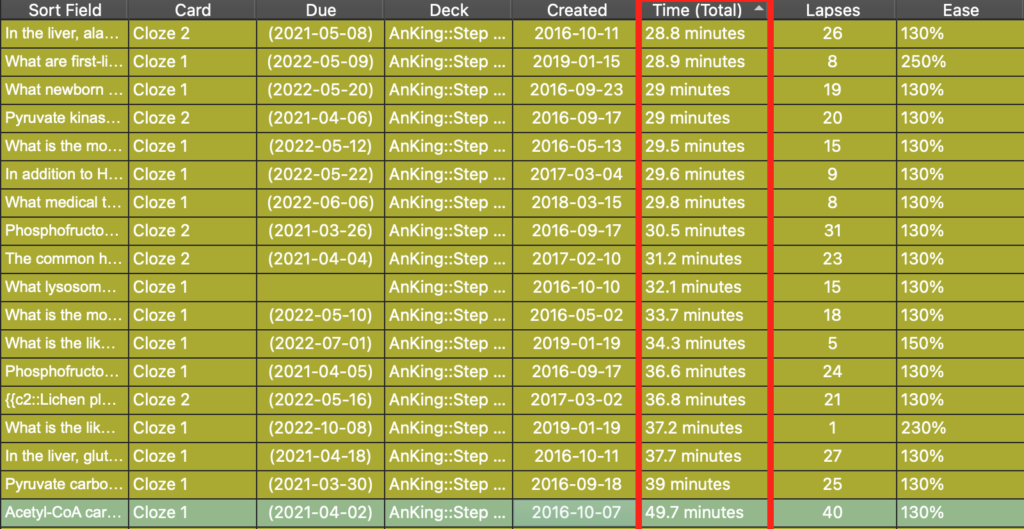
You will notice certain cards have large amounts of time spent on them; also, look at the ease interval; if you hit “again” so many times on these cards, they will show up a crazy amount. I am better off, for many of them, just suspending them. These <1% of cards take up too much time; I am sucking away potential knowledge from other topics by reviewing these.
So, what I would do, I review the 1-5% of cards that you are spending the most time on by using the advanced browser app; then, if there is a topic or theme, see if this is an important topic that is worth you spending the extra time to review. Otherwise, suspend it. For example, my worst card is about 50 minutes, which is a long time, about fatty acid metabolism I permanently suspended.
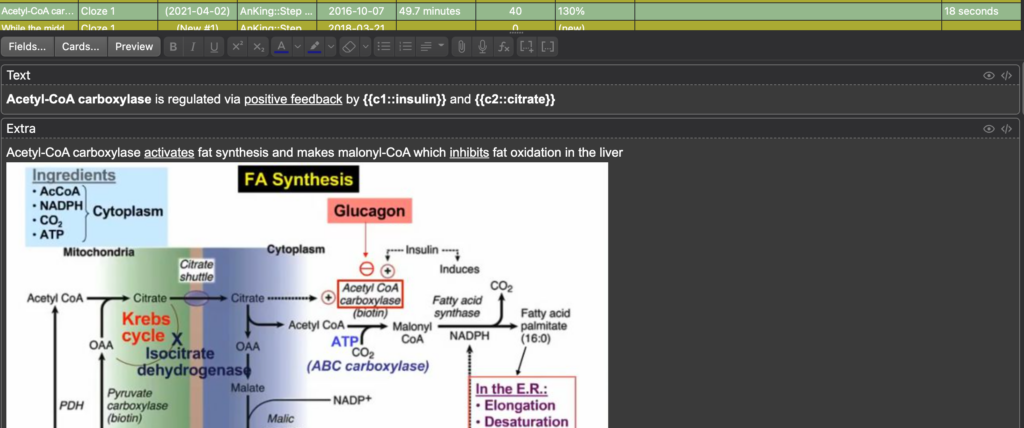
6. Making Simpler cards
In general, more straightforward cards are better. The reason being we want to use reverse learning as well to understand the topic better. If the flashcards are a paragraph in length, we will be adding many cloze deletions for the card to make sense.
Sometimes, some mnemonics involve you memorizing 9+ terms, having nine cloze deletions is a wrong move. The reason being, especially using my settings, this card will take over ten days to go through completely. The second reason is that every time you see that card, you are reminded of all of the items in the mnemonic. Instead, I would have one card that asks the question and then take the time to go over the mnemonic in my head, defining every term. For example, I changed the following card:

The above card will create 8 flashcards, I would simply have it as all one:

7. Understand the settings
Finally, to use Anki correctly, you should understand the settings. I have an in-depth post on this, but you can also find other great videos on YouTube defining the settings.
Things I would make sure to learn about include:
- decks and tags
- ease hell
- learning steps and graduated cards
- Lapses
- Burying
Understanding the Anki settings is vital to maximizing your potential with Anki. There are a couple good videos on YouTube that go in-depth on the settings.
Otherwise, I’ve been using Anki for over three years; I’ve spent over 3,000 hours with it and reviewed over half a million flashcards. I know a good amount about Anki. Throughout my Anki journey, I learned every nook and cranny of the application and how it is amazingly powerful. I wouldn’t have survived medical school without it, so I wanted to make a complete guide on how to start using and get the absolute most out of Anki, and I did!
My Ultimate Guide to Anki is a full-length class hosted on skillshare here.
2 Comments
Nicolas · August 1, 2023 at 1:57 pm
I have the newest version of Anki and it doesn’t start in full screen mode anymore. Do you know a fix how to get Anki to open in a large window instead of a small one?
Greetings from Austria!
Zach · November 18, 2023 at 8:50 am
I would just open it, and then expand the window (stretch it by pulling on the corners) to full screen. Next time you open it it should be relatively full screen.